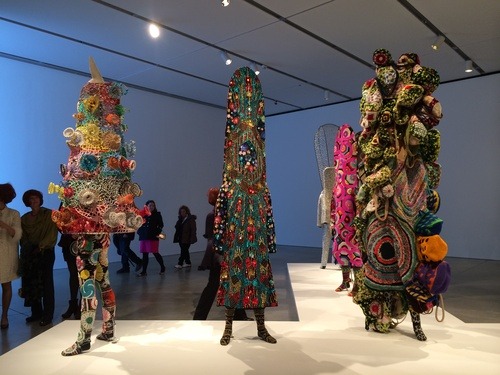Nick Cave and William Kentridge at the ICA
This past Sunday, we visited the ICA in Boston, one of my favorite art museums ever.
Nick Cave (not the singer) and William Kentridge were on show.
New Yorkers may remember Nick Cave for his Grand Central Station performance with the colorful horses. I did not manage to witness that particular spectacle, but his work at the ICA gave me a pretty good idea of what he’s about.
Turns out, he’s a former Alvin Ailey dancer. So his work is as much about movement as it is about visual form. He’s best known for his Soundsuits, which are like colorful full-body masks, intended to be worn by dancers and actors. Conceptually, they are meant to protect against the traumas of modern living, but I think they are just cool-looking. I would like to wear one for a day and see the streets of NYC from inside it. Or just at home hanging out on the couch.

I especially love his Pogo series, which was not on view, but the Mediatheque featured a video of it.
The art world apparently doesn’t think Cave’s work is very conceptually rigorous, but how can you argue with these Pogo dudes??
William Kentridge’s piece was a mixed media, 20-minute video piece called “The Refusal of Time.” You enter a dark room. In the center is a creaky, perpetually moving wooden structure meant to evoke a French time-keeping breathing apparatus from the 19th century. The movie begins, and five projections around you tell a densely multilayered, disorienting, decidedly non-linear story involving relativity, constellations, optical telegraphs, colonialism, domestic tensions, dancers, and tubas. Somewhere in there is a vignette of a French anarchist’s attempt to blow up the Britsh Royal Observatory at the Greenwich Meridian. The Observatory was a potent symbol of Imperialist Britain’s attempt to dominate not just its colonial subjects but time itself, so the meaning of the title takes on a new meaning: it’s not just the refusal of time, but the refusal of any one nation’s control over it. Of course, I didn’t get any of this until the piece ran its course and I went outside to read the wall text.

I first heard of William Kentridge while at SMFA, where one of his time-lapse drawing pieces was on show in the school’s atrium. I remember him best for these swirly animations where he draws erases, smears, and draws over the same sheet again with charcoal.
I found out this weekend that he’s South African. His parents were both lawyers, prominent defenders of victims of apartheid. Not knowing that, his works seemed just like formal play with mark-making, but turns out they actually carry a lot of political meaning. Given his experiences and perspective, they start to feel more shifty and unsettled than playful.
I’ve long since forgotten much of the art history I learned in college, but art still captivates me. As a communication medium, it’s fairly dysfunctional, and this used to be my biggest frustration with it as a student. Most of us rely on wall texts for an incomplete, at best, interpretation, and we are left to imagine the rest of what the artist was trying to say. But now I realise, that’s not the point – art is not a signalling channel but a mirror. It reflects and amplifies back to you what you care about, feel in the moment. All you have to do is be sensitive to those wavelengths and you’ll have a remarkable experience.